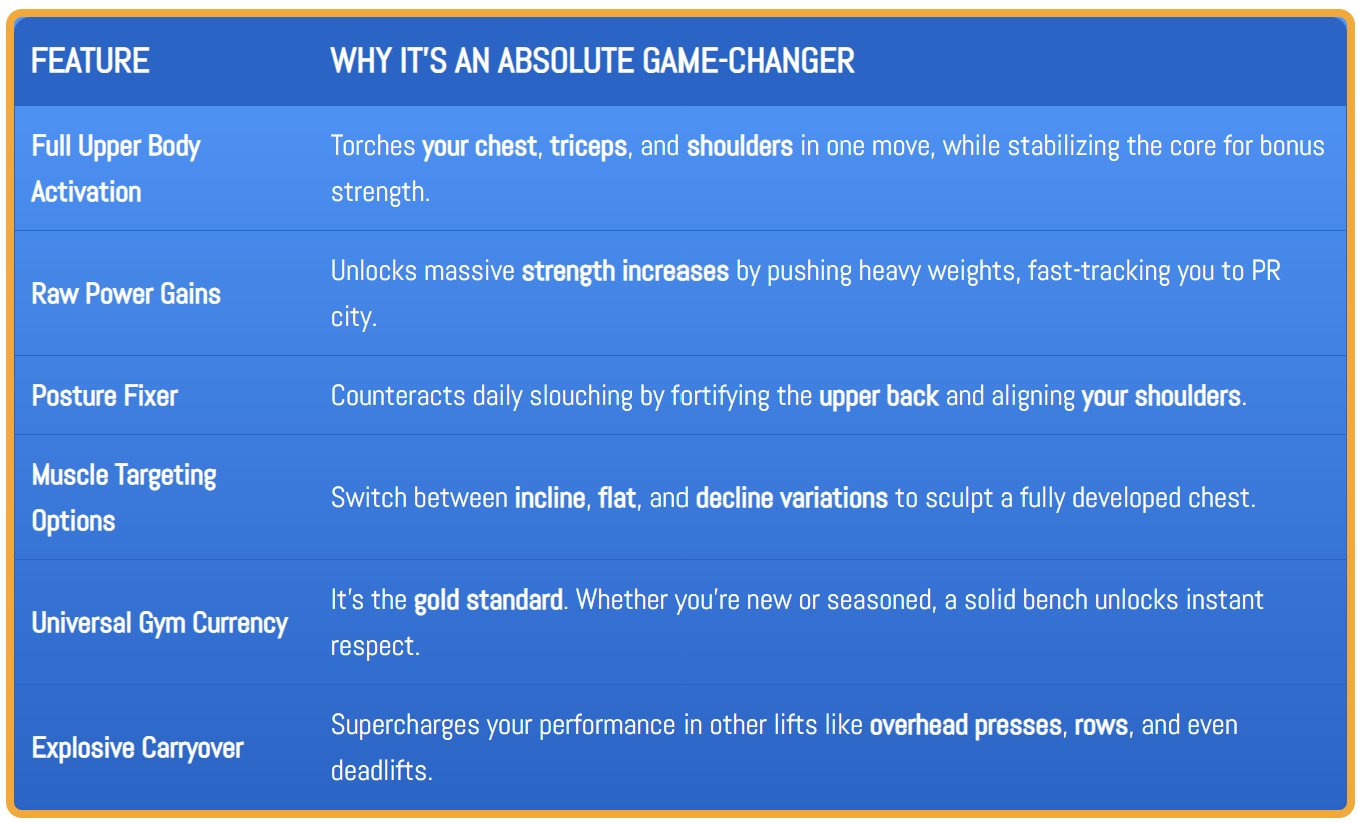The bench press isn’t just an exercise; it’s the cornerstone of building upper body strength. Walk into any gym, and you’ll see both beginners and seasoned lifters treating it like the holy grail. Why? Because it’s a powerful movement that engages your chest, shoulders, and triceps in one smooth motion. But here’s the kicker—most people are doing it wrong, leaving gains on the table and risking injuries.
Let’s fix that. This guide is your fast track to bench press mastery, outlining the proper techniques, common mistakes, and all the juicy benefits that come with it. Whether you’re a novice or an experienced athlete, the bench press can transform your training routine—if you know what you’re doing.
Why the Bench Press is the King of Upper Body Exercises
It’s not just about lifting weights; it’s about unlocking your full potential. With proper technique, you’ll build strength, avoid injuries, and become a powerhouse in the gym.
Mastering Proper Bench Press Form
The key to building strength and avoiding injuries? Proper form. Here’s how to set yourself up for success:
- Setup is Crucial
- Lie flat on the bench with your feet firmly planted on the ground.
- Position your shoulders down and back to stabilize your upper body.
- Keep your eyes directly under the barbell—this is your starting point.
- Grip it Right
- Use a medium grip, with hands slightly wider than shoulder-width.
- Avoid going too narrow (risking triceps overload) or too wide (risking shoulder strain).
- Execution: The Lift
- Unrack the bar and lower it to your sternum in a controlled motion.
- Don’t bounce it off your chest; that’s how injuries happen.
- Press the bar straight up until your arms are fully extended.
- Maintain Stability
- Keep your core tight and your feet planted throughout the lift.
- Avoid arching your back excessively—it’s tempting but unnecessary for most lifters.
The Variations You Need in Your Workout Routine
| Variation | Target Area | Benefits |
|---|---|---|
| Flat Bench Press | Middle chest, triceps, shoulders | Most popular, builds overall chest strength. |
| Incline Bench Press | Upper chest, shoulders | Focuses on the upper chest for a fuller, rounded look. |
| Decline Bench Press | Lower chest, triceps | Targets the lower pectoral muscles effectively. |
| Dumbbell Bench Press | Stabilizers, deeper muscle engagement | Increases range of motion and corrects imbalances between sides. |
| Close-Grip Bench | Triceps | Maximizes triceps activation for a stronger lockout. |
Each variation has its place. Rotate these into your routine to target all areas of your chest and upper body.
Benefits of Bench Pressing Correctly
- Engages Multiple Muscle Groups
You’re not just hitting your chest—you’re working triceps, shoulders, and stabilizers. This builds balanced strength across your upper body. - Corrects Imbalances
Done right, it addresses missed gains by strengthening weak points and aligning posture. - Builds Confidence
Lifting heavier on the bench translates into real-life power—and yes, it looks cool, too. - Solid Foundation for Other Lifts
A strong bench means stronger overhead presses, rows, and even deadlifts. It’s all connected.
Avoiding Common Bench Press Mistakes
Here’s what not to do:
- Bouncing the Bar Off Your Chest: It’s lazy and dangerous.
- Flared Elbows: Keep them at a 45-degree angle to protect your shoulders.
- Arching Your Back: Some arch is okay, but don’t turn it into a backbend.
- Uneven Grip: A crooked bar is a recipe for disaster.
- Skipping Warmups: Cold muscles = high injury risk.
Q&A: Rare Bench Press Questions Answered
Q: Can bench pressing help with shoulder injuries?
A: If done correctly, yes. Proper form strengthens the deltoids and stabilizers, improving shoulder health. But if you’re already injured, start with lighter weights and consult a physical therapist.
Q: Should I bench with my feet on the bench or the ground?
A: Ground, always. This gives you a stronger base and helps generate power. Feet on the bench? That’s a fast track to instability and reduced strength.
Q: Is dumbbell pressing better than barbell pressing?
A: Not better—different. Dumbbells offer a greater range of motion and correct imbalances, but barbells allow you to lift heavier. Use both for maximum results.
Q: How much should I bench compared to my body weight?
A: For beginners, aim for your body weight. Seasoned lifters should hit 1.5x their weight for solid strength.
Q: Can I bench press every day?
A: Nope. Overtraining leads to injuries and stalls progress. Stick to 2-3 times a week, with rest in between.
Final Thoughts: Master the Bench Press
The bench press is more than just a lift—it’s the foundation of upper body strength. Whether you’re training for power, size, or general fitness, this exercise delivers when done right. Follow the techniques, avoid common mistakes, and integrate variations into your routine.
Remember: proper form is king. It’s not just about lifting weights; it’s about maximizing your performance while staying safe. Whether you’re here to build muscle, improve your posture, or simply lift like a beast, the bench press is your ticket to success. Now, get under the bar and start crushing it.

